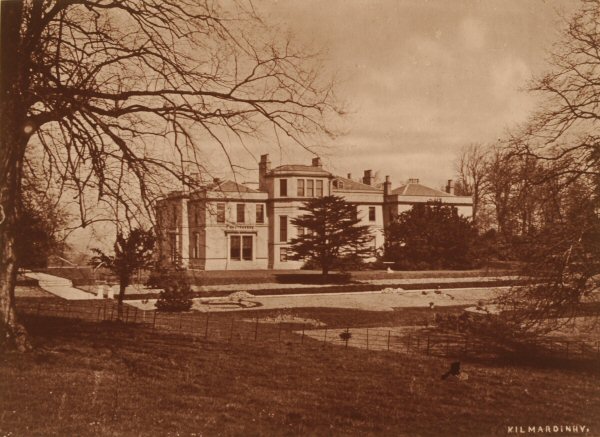

THIS small estate is situated in the parish of New Kilpatrick and county of Dumbarton, about six miles from Glasgow. It is the property of Robert Dalglish, Esq.
In ancient times the five pound lands of Kilmardinny formed part of the great Earldom of Lennox. (1)
In 1465 Sir John Colquhoun of that Ilk had a charter, under the Great Seal, of a portion of them, and the remainder went to the Lennoxes of Balcorrach, whose descendants are the present family of Lennox Castle.
The Colquhouns, who had large estates in this neighbourhood, held their part of Kilmardinny for many generations. John Colquhoun, "fiar of Kilmardonie," is mentioned in a marriage contract in 1671, (2) and in the beginning of the eighteenth century they still possessed it.
After the Colquhouns, Kilmardinny became the property of a family of Grahams, cadets of the old family of Dougalston. On the death of John Graham (3) the estate was purchased by the Rev. Andrew Gray, minister of the parish of New Kilpatrick, in which Kilmardinny is situated.
The Rev. Andrew Gray was the eldest son of the Rev. John Gray of the Dalmarnock family, minister of the Wynd, and afterwards of St. Andrew's Church in Glasgow. Andrew Gray was presented in 1730 to the parish of New Kilpatrick by James, Duke of Montrose, and after some opposition was settled. Wodrow, in speaking of this settlement, says, "I am sorry so good a youth as Mr. Andrew Gray should be the subject of so much strife. They are fighting against their own mercy. He is a choice deserving person." (4) On Mr. Gray's death (5) in 1776 he was succeeded by his nephew, John Gray.
John Farquhar Gray (as he was afterwards styled) of Gilmilnscroft, in Ayrshire and Kilmardinny, was the eldest son of the Rev. James Gray, minister of Strathblane, who was half-brother of the minister of New Kilpatrick. In 1777 he married Jane Farquhar, only daughter and heiress of Alexander Farquhar of Gilmilnscroft, and assumed the name of "Farquhar." By him Kilmardinny, which at that time was a nice compact estate of about two hundred acres, was divided and sold in four separate portions.
The principal part, with the mansion house, was bought by Mrs. Helen Colquhoun, widow of William Colquhoun of Garscadden. About the beginning of this century she sold her part to John Leitch, of the well known firm of Leitch & Smith, West India merchants in Glasgow. He afterwards acquired one of the other portions also. From John Leitch, Kilmardinny passed to the family of his nephew, James Leitch, in whose possession it remained till 1833.
William Brown, merchant in Glasgow, then acquired it. He is of an old Glasgow family, (6) and is a very well known citizen. He was Dean of Guild in 1837, and again in 1857, and still survives in active old age. He sold Kilmardinny in 1844.
William Whyte, merchant in Glasgow, and previously in Gibraltar, was the next proprietor; he held Kilmardinny till 1853, when he sold it to the present proprietor.
Robert Dalglish is the head of the extensive calico printing firm of Dalglish Falconer & Co. His father was Provost Dalglish, and his brother was the well known citizen Andrew Stevenson Dalglish. Robert Dalglish was M.P. for Glasgow from 1857 to 1874, and was one the ablest and most popular representatives we have had.
The last two proprietors had each bought parts of one of the other portions of Kilmardinny, and Robert Dalglish having done so also, now possesses about half of the original undivided estate.
Since a very early date there has been a mansion house on this property. When John Leitch acquired it, he built a new front and made other alterations. William Brown also made some small additions and improvements. The present proprietor, however, has completely altered the house, and from the designs of James Smith, architect in Glasgow, has made it a very handsome and commodious mansion.
(1) Chartulary of Lennox.
(2) Maxwells of Pollok.
(3) John Graham was the grandfather of the late Lilias and Janet Graham of Gairbraid; the latter married Alexander Dunlop of Keppoch, and the family of her eldest son John are now the proprietors of Gairbraid.
(4) After being presented, and when his trials were nearly over, on his being appointed to supply the parish on Sunday, 21st February, a disgraceful riot took place, not against the presentee but the patron, in which the heritors and parishioners were nearly equally divided. The lairds of Mains, Succoth, Kilmardinny, Kilmannan, and their sons and servants, assembled in the morning, seized the keys of the church, filled the pulpit with stones, &c., and barricaded the doors. The Sheriff of the county, Mr. Colquhoun of Garscadden, with Mr. Hamilton of Hutchison and others, attempted to force an entrance, but were wounded and driven off, and finally Mr. Gray retired. Criminal letters were raised and came before the Lords of Justiciary at Glasgow the same year, but the gentlemen having acknowledged their offence to their Lordships in private, the matter was passed over. Mr. Gray was ordained without further opposition - (Fasti Ecclesiae Scoticanae).
(5) An old woman, a native of Kilpatrick, who was born in 1719, and died at the great age of 102, was accustomed to relate having seen the reverend gentleman exorcise a Highland witch, who had practised some of her incantations on one of the parishioners, who was "wasting away." After the minister had concluded the prayer usual on such occasions, he cried out in a loud voice, "Satan, foul fiend, begone from this parish!" The parishioner recovered.
(6) William Brown is descended, by his father's side, from the Browns of Broadstone in Ayrshire, and, by his mother's, from the old Glasgow families of Reids and Euings.
Back to Contents